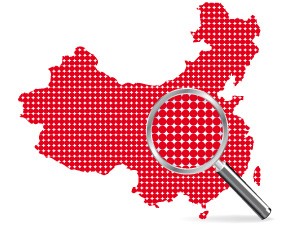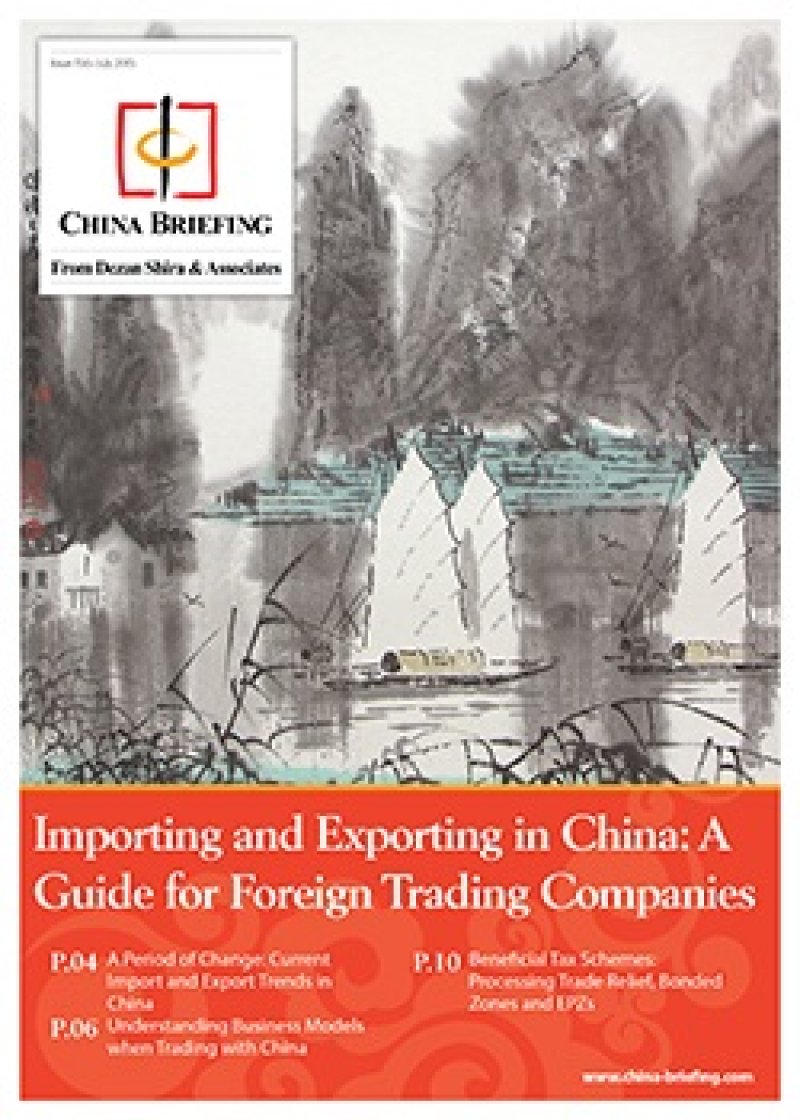Intellectual Property Rights for SMEs in China’s ICT Industry
 By Alex Bayntun-Lees at the China IPR SME Helpdesk
By Alex Bayntun-Lees at the China IPR SME Helpdesk
China’s IPR (intellectual property rights) protection system is expanding and improving, but it remains vastly different from the European system. Accordingly, to be successful in China a business must take preventative measures to protect its intellectual property rights; one must obtain valid IPR rights in China as a minimum first step. In other words, the protection of IPR rights should be a key part of a company’s business strategy, whether entering or expanding operations in China.
While some IPR issues are common to all types of European companies doing business in China, others are specific to the ICT industry. In this article, we outline appropriate patent and trade secret strategies, the type of patents particularly relevant to ICT (information & communication technology) companies, and suitable IPR enforcement measures. Enforcement of IPR is discussed through a case study of an IT company that has taken enforcement actions in China.
Developing a patent and trade secret strategy for China
Patent Protection
China has three types of patents: invention patents, utility model patents, and design patents. For a hardware invention, all three should be considered; this is because each will help to protect your product in different ways.
Invention patents cover products that provide solutions to technological problems – they are more ‘inventive’ than utility model patents, which essentially provide protection for technological ‘upgrades’. Companies developing software inventions should consider filing for protection under an invention patent. The Chinese patentability standards for software inventions are similar to those in Europe. Thus, a software invention that is patentable in Europe should generally be patentable in China, although the patents should also be registered separately in China. An invention patent lasts twenty years and should be used to protect inventions with a relatively long life. The duration of a utility model patent is only ten years. Since the ‘novelty threshold’ for utility model patents is lower than that for invention patents, utility model patents are suitable for incremental inventions and technologies with a shorter life span.
Since Chinese companies can freely access patent information in Europe and the USA, it is advised that companies register their invention and utility model patents in China before their inventions are released anywhere in the world. If your invention or utility model is disclosed to the public before it has been patented (i.e. it is no longer ‘novel’), it is no longer possible to apply for a patent.
Design patents protect the ‘look’ – or cosmetic appeal – of a product. In the EU, designs are automatically protected for three years. This is different in China, where if you do not register your design patent before you disclose it to the public in any way (anywhere in the world), it can no longer be protected by a design patent.
![]() RELATED: IT-Based Solutions from Dezan Shira & Associates
RELATED: IT-Based Solutions from Dezan Shira & Associates
Trade Secret Protection
Trade secrets include confidential business information that may provide your company with a competitive advantage over others. Unbeknown to many, trade secrets can be extremely valuable intellectual property. However, since they are not registrable rights, protection strategies adopted by EU SMEs should be considered carefully.
Trade secrets can include a myriad of technologies, including source codes (to the extent that they cannot be reverse engineered). Trade secrets can also include operational information, such as processes and methods; or other information, such as marketing strategies and customer lists, so long as they meet all of the below requirements.
A trade secret is defined as:
- Technical and business information that is unknown to the public;
- Information that has economic value and practical utility; and
- Information that the trade secret owner has palpably protected – the owner should have undertaken (demonstrable) measures to ensure its confidentiality.
Although trade secrets can be protected by a confidentiality agreement – as in Europe – it is also recommended that recipients of confidential information should sign an acknowledgement prior to receiving such information. If it later becomes necessary to file a misappropriation action, a trade secret owner must provide appropriate evidence to show that the trade secret meets the above requirements, in addition to proving there has been misappropriation of the trade secret by a wrongdoer or a third party.
In the case of trade secrets, prevention is the best strategy. However, companies that take enforcement actions can, and have, received positive outcomes from Chinese courts.
FRAND: Interface of standards and patents
While in the past it was viable to obtain patents according to industry standards, recent developments in the law on Standard Essential Patents (“SEPs”) have changed this. A standard essential patent is a patent that claims that an invention must comply with a technical standard.
Standards for different industries are set by regional organizations, such as The European Telecommunications Standards Institute (ETSI), which amongst other standards covers wireless communications. Due to inter-operability requirements on this technology, certain ETSI standards are adopted in China.
ETSI generally does not determine whether a particular patent is essential to a standard. Rather, it provides a mechanism by which the patent owner themselves can make a declaration of essentiality, coupled with a commitment to license any SEPs on Fair, Reasonable, And Non-Discriminatory (“FRAND”) terms and conditions. Therefore, where a European patent is declared by the patent owner as essential to an ETSI standard, the Chinese patent corresponding to the European patent is also considered essential in China. Thus FRAND terms and conditions will also apply.
If a patentee engages in standard-setting or agrees that a patent should be incorporated into a national, industrial or local standard, this permits others to exploit the patent for implementation purposes. Those using the patented technology to implement the standard may be charged royalties by the patentee for use of the patent, but are not deemed to be committing an infringement.
SEPs versus implementation patents
Implementation patents refer to patents that are not incorporated into a standard but facilitate the implementation of the standard. For example, a patent on a new form of touch-screen glass is not essential to the 5G wireless standard. However, if the innovation was considered superior to the extent that all 5G phones incorporated it, such a patent would be invaluable.
As implementation patents are not incorporated into standards they are not subject to FRAND obligations, so customary infringement damages and injunctive relief are available. Therefore, due to the lower royalties available due to FRAND conditions, implementation patents are often more valuable for EU SMEs.
 RELATED: Intellectual Property in China’s Food & Beverage Industry
RELATED: Intellectual Property in China’s Food & Beverage Industry
Enforcement
China is the most litigious country for IP disputes in the world in absolute terms. 87,419 IP suits were filed in Chinese courts in 2012. However, out of these only about 1,400 foreign companies participated, which means that less than two percent of Chinese IP disputes involved foreign parties.
The reluctance by foreign companies to enforce their IPR rights in China is largely due to the perception that China does not protect IPR and that foreign companies won’t get fair treatment. However, such reluctance is misplaced: evidence suggests that case outcomes are not affected by litigants’ nationalities or, in short, the Chinese IPR system has reached a point at which foreign companies can get justice through a number of channels.
Enforcement cases concerning ICT technology in China can be very complex, given the consideration of individual IP rights and industry standards that is often required. Therefore, it is beneficial for an ICT company that deals predominantly with incremental technology development to consider their rights and how they may conflict with certain competitive market laws.
ICT company case
InterDigital, Inc. is a mid-sized U.S. wireless research and development company. In July 2011, it filed a complaint with the United States International Trade Commission (USITC) against Nokia Corporation and Nokia Inc., Huawei Technologies Co., Ltd and its affiliates, and ZTE Corporation and its affiliate, alleging patent infringement of certain 3G wireless devices, such as WCDMA- and CDMA 2000-capable mobile phones, USB sticks, mobile hotspots and tablets and components of such devices.
Actions taken
In December 2011, Huawei filed two suits against InterDigital in the Shenzhen Intermediate People’s Court in China. The first suit alleged that InterDigital had a dominant market position in China and the United States for the licensing of standard essential patents (SEPs) (inventions that must be used to comply with technical standards) owned by InterDigital, and abused its market power by engaging in unlawful practices, including differentiated pricing, tying, and refusal to deal. The second suit alleged that InterDigital failed to negotiate on Fair, Reasonable, and Non-Discriminatory (FRAND) terms with Huawei – a requirement of owners of SEPs. It asked the court to determine the FRAND rate for licensing essential Chinese patents to Huawei and also sought compensation for its costs associated with this matter.
Outcome
In February 2013, the Shenzhen Intermediate People’s Court ruled that the royalties to be paid by Huawei for InterDigital’s 2G, 3G, and 4G standard-essential patents should not exceed 0.019% of the actual sales price of each Huawei product. This appears to be the first time that any judicial authority has ruled on the appropriate royalty rate for a FRAND encumbered standard essential patents (SEP) – a patent that defines an invention that must be used to comply with a technical standard.
With respect to the first suit, the court held that InterDigital violated China’s Anti-Monopoly Law by (1) making proposals for royalties from Huawei that the court believed were excessive; (2) tying the licensing of essential patents to the licensing of non-essential patents; (3) requesting as part of its licensing proposals that Huawei provide a grant-back of certain patent rights to InterDigital; and (4) commencing a United States International Trade Commission (USITC) action against Huawei while still in discussions with Huawei for a license. The court ordered InterDigital to cease the alleged excessive pricing and bundling of InterDigital’s Chinese essential and non-essential patents, and to pay Huawei approximately US$3.2 million in damages. The court dismissed Huawei’s remaining allegations, including Huawei’s claim that InterDigital improperly sought a worldwide license and improperly sought to bundle the licensing of essential patents on multiple generations of technologies.
With respect to the second suit, the court determined that, despite the fact that the FRAND requirement originated from the European Telecommunications Standards Institute’s (ETSI) IPR policy, which refers to French law, InterDigital’s license offers to Huawei should be evaluated under Chinese law. Under Chinese law, the court concluded that the offers did not comply with FRAND.
InterDigital is reported to have filed appeals to both decisions.
IP lessons and take-away messages
- FRAND is not an essential patent holder’s friend.
- Enforcing SEPs is problematic in China: injunctions may not be possible; royalties are lower than normal.
- Antitrust enforcement further limits the value of SEPs.
- Enforcement of SEPs outside China may give rise to countersuits in China.
- Software inventions can be protected in China, as in Europe.
- Utility model patents can play an important role in your Chinese patent portfolio.
- Implementation patents are much more valuable than standard essential patents.
- Trade secret protection should be complimented by additional confidentiality measures that require signed acknowledgements.
- IP enforcement in China is improving, though cumbersome evidence rules make it difficult to enforce.
|
The China IPR SME Helpdesk, is a European Union co-funded project that provides free, practical, business advice relating to China IPR to European SMEs. To learn about any aspect of intellectual property rights in China, including Hong Kong, Taiwan and Macao, visit our online portal at www.china-iprhelpdesk.eu. For free expert advice on China IPR for your business, e-mail your questions to: question@china-iprhelpdesk.eu. You will receive a reply from one of the Helpdesk experts within three working days. The China IPR SME Helpdesk is jointly implemented by DEVELOPMENT Solutions, the European Union Chamber of Commerce in China and European Business Network (EBN).
|
![]()
 An Introduction to Doing Business in China 2015
An Introduction to Doing Business in China 2015
Doing Business in China 2015 is designed to introduce the fundamentals of investing in China. Compiled by the professionals at Dezan Shira & Associates, this comprehensive guide is ideal not only for businesses looking to enter the Chinese market, but also for companies that already have a presence here and want to keep up-to-date with the most recent and relevant policy changes.
 Selling, Sourcing and E-Commerce in China 2016 (First Edition)
Selling, Sourcing and E-Commerce in China 2016 (First Edition)
This guide, produced in collaboration with the experts at Dezan Shira & Associates, provides a comprehensive analysis of all these aspects of commerce in China. It discusses how foreign companies can best go about sourcing products from China; how foreign retailers can set up operations on the ground to sell directly to the country’s massive consumer class; and finally details how foreign enterprises can access China’s lucrative yet ostensibly complex e-commerce market.
Importing and Exporting in China: a Guide for Trading Companies
In this issue of China Briefing, we discuss the latest import and export trends in China, and analyze the ways in which a foreign company in China can properly prepare for the import/export process. With import taxes and duties adding a significant cost burden, we explain how this system works in China, and highlight some of the tax incentives that the Chinese government has put in place to help stimulate trade.
- Previous Article Living to Fight Another Day: Putting a Chinese Company in “Dormancy”
- Next Article China Regulatory Brief: FTA between China and South Korea and China’s Revised Draft Patent Law




























